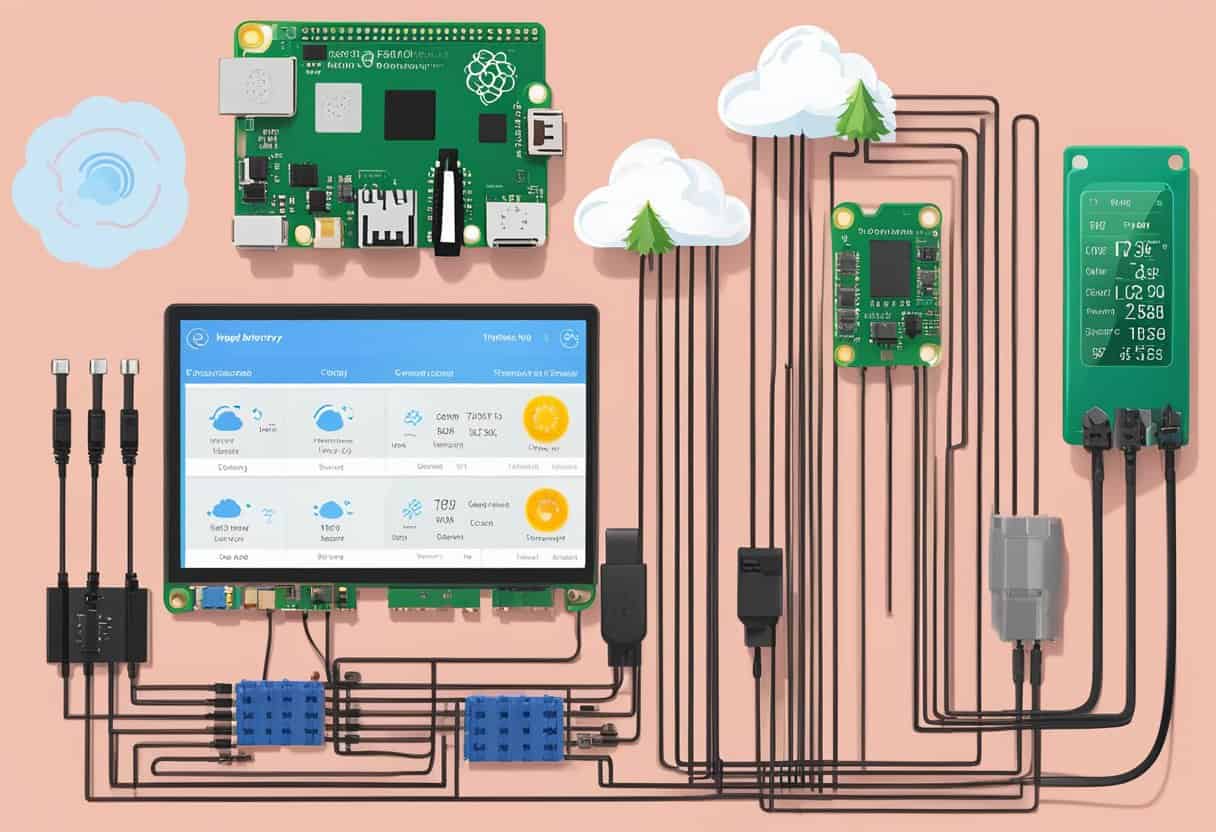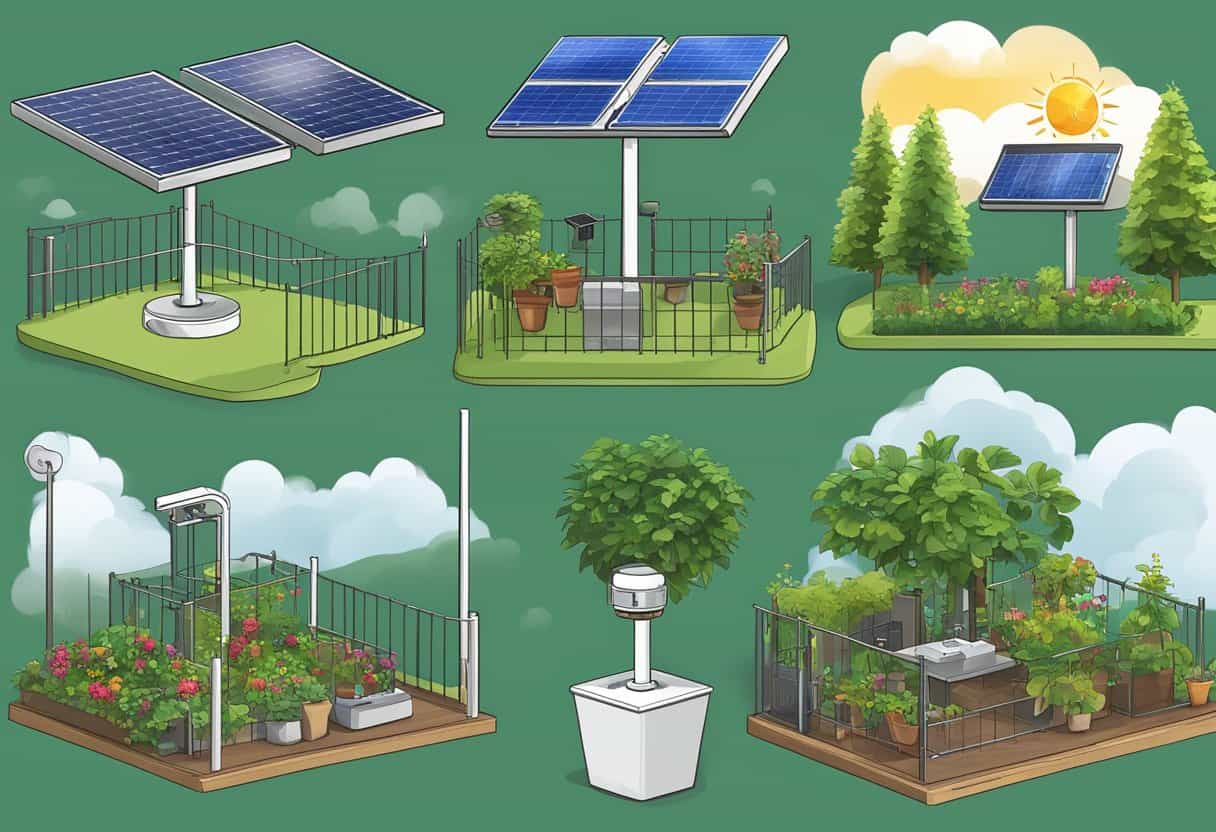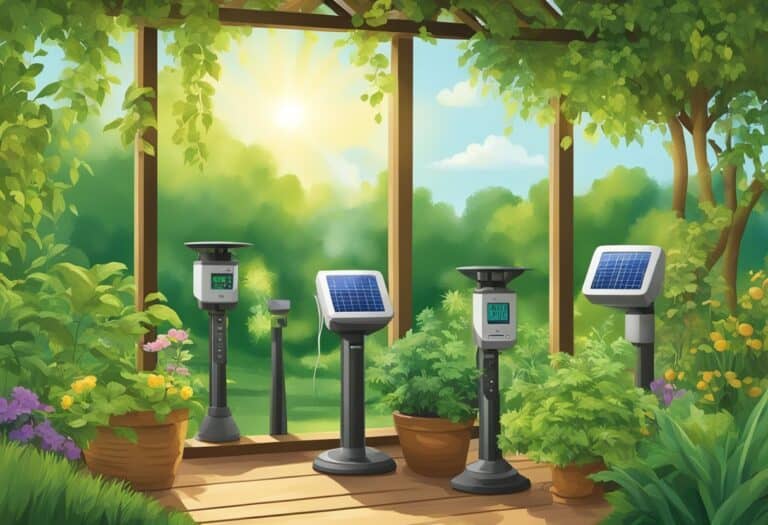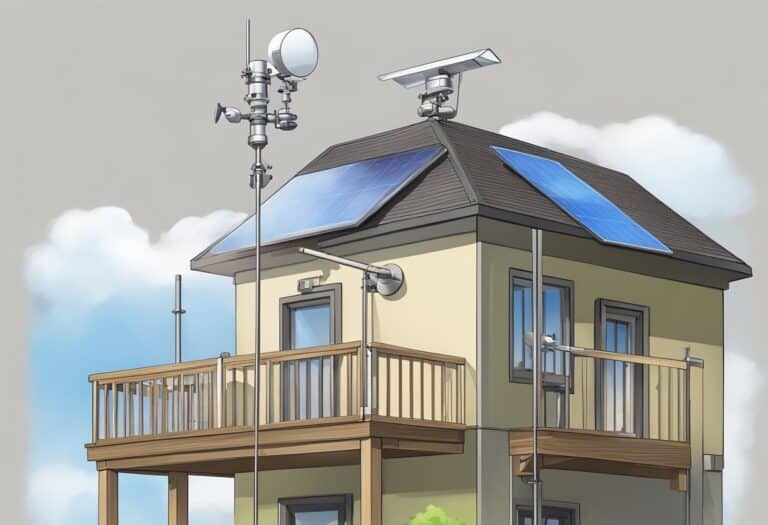Building a DIY Raspberry Pi Weather Station is a project that blends electronics, programming, and environmental science.
By creating your own station, you gain the ability to monitor weather conditions with a level of customization and cost-effectiveness that is not easily achievable with off-the-shelf products. The Raspberry Pi, a versatile and powerful single-board computer, lies at the heart of this DIY project. It enables enthusiasts and educators alike to gather and analyze meteorological data such as temperature, humidity, atmospheric pressure, and more.
Embarking on this project requires assembling various sensors and components, setting up the Raspberry Pi’s operating system, and employing programming languages like Python to process and visualize data. Not only does this endeavor enhance your understanding of weather systems, but it also sharpens your skills in hardware integration and software development. Additionally, by connecting your weather station to online services, you can share your findings with the world or even contribute to citizen science initiatives.
The project is not without its challenges, but troubleshooting and maintaining your setup is part of the learning curve that enriches the DIY experience.
Creating a DIY Raspberry Pi Weather Station involves assembling sensors and programming with Python to measure environmental data. This project enhances understanding of weather systems and technical skills, offering opportunities to share data online and contribute to citizen science. It’s a hands-on learning experience in both hardware and software development.
Required Materials and Tools
Building a DIY Raspberry Pi weather station requires careful planning and specific materials. You’ll need a variety of sensors and tools to complete your project, ensuring it’s functional and durable for environmental data collection.
Raspberry Pi and Accessories
- Raspberry Pi: The brain of your weather station; choose a model with sufficient computing power.
- MicroSD Card: Get a high-quality card with at least 8GB capacity for the operating system and software.
- Power Supply: A stable and reliable power source for your Raspberry Pi is crucial.
- Keyboard, Mouse, and HDMI Cable: Necessary for initial setup and programming of your Raspberry Pi.
- LCD Screen: Useful for displaying real-time weather data.
Weather Station Sensors
- Temperature and Humidity Sensor: To measure atmospheric conditions.
- Barometric Pressure Sensor: Essential for forecasting weather changes.
- Wind Speed and Direction Sensors: For tracking wind-related data.
- Rain Gauge: To measure precipitation.
Building Materials for Enclosure
- Plexiglass or Weatherproof Enclosure: To protect your weather station from the elements.
- Drill and Drill Bits: For creating mounting holes in the enclosure.
- Glue Gun and Adhesives: To seal and secure components inside the enclosure.
Electronics and Cables
- Soldering Kit: For securing connections and ensuring component compatibility.
- Jumper Wires and Breadboard: For prototyping and testing your circuit before final assembly.
- Cables: Various cables to connect sensors to the Raspberry Pi.
- Resistors and LEDs: For indication lights and managing current flow in your circuits.
Setting Up Raspberry Pi OS

Setting up the Raspberry Pi OS is the foundational step for your DIY weather station. It involves installing the operating system, configuring network settings, and setting up remote access.
Installing the Operating System
Start by downloading the Raspberry Pi Imager to your computer. This tool simplifies the process of writing the Raspberry Pi OS image to a MicroSD Card. After the download, insert the MicroSD Card into your computer’s card reader. Open the Imager, select the right OS version, and write it to the card. Allow some time for the process to complete before safely ejecting the card.
Configuring Network Connections
Once your Raspberry Pi boots up from the newly installed OS, you’ll need to configure your network connections for updates and remote management. On the desktop GUI, find the network icon and connect to your WiFi network by entering the appropriate credentials. Alternatively, plug in an Ethernet cable for a wired connection, which may offer a more stable network.
SSH and Remote Access
For remote access to your Raspberry Pi, you’ll need to enable SSH (Secure Shell). In the terminal, type sudo raspi-config to open the configuration tool. Navigate to ‘Interfacing Options,’ select ‘SSH,’ and choose ‘Yes’ to enable. Ensure your Raspberry Pi is connected to your network to access it from another computer on the same network using an SSH client with your Pi’s IP address.
Assembling the Hardware
When assembling the hardware for your DIY Raspberry Pi Weather Station, precision and attention to detail will ensure that your sensors capture accurate data. You’ll connect multiple sensors to the Raspberry Pi, apply conformal coating for protection, and weatherproof all external components.
Connecting Sensors to Raspberry Pi
To begin, you’ll need to connect several sensors to your Raspberry Pi to measure environmental parameters. Your essential sensors include:
- Light Sensor: Measures light intensity.
- Pressure Sensor: Records atmospheric pressure, which is crucial for forecasting weather conditions.
- Temperature and Humidity Sensor: Often combined in a single unit, this sensor tracks both ambient temperature and humidity levels.
- Anemometer: Gauges wind speed and may include a direction vane.
- Rain Gauge: Collects and measures precipitation.
Connect each sensor to the GPIO pins on the Raspberry Pi using jump wires, ensuring a secure connection for reliable data transmission. Refer to specific pin layout diagrams to match each sensor’s requirements.
Protecting Electronics with Conformal Coating
Once connected, safeguard your electronic components by applying conformal coating to the circuit board. This coating:
- Provides a layer of defense against moisture.
- Helps prevent corrosion and short circuits.
Carefully apply the coating to each sensor board and the Raspberry Pi, avoiding connectors and moving parts, such as switches.
Weatherproofing the External Components
Lastly, it’s essential to house all external components within a weatherproof enclosure to protect against the elements. Consider these steps:
- Choose an enclosure rated for outdoor use with enough space for air circulation and mounting your sensors.
- Use grommets and weatherproof seals for any wiring that exits the enclosure to prevent water ingress.
- Position the anemometer and rain gauge in clear, unobstructed locations to ensure accurate readings.
Weatherproofing your hardware with an appropriate enclosure will extend the life and performance of your DIY Raspberry Pi Weather Station. Remember, when assembling the hardware for your weather station, take care to ensure that each part is properly connected, coated, and shielded from the weather to provide the best possible data for your observations.
Programming Raspberry Pi
When you decide to create a DIY weather station with Raspberry Pi, your main task will involve programming the device to collect, process, and store data. Mastery of Python, a versatile language supported by Raspberry Pi, will enable you to write scripts effectively and utilize various sensors to monitor environmental conditions.
Writing Python Scripts for Data Collection
Python is the primary language you’ll use to write scripts for data collection. Your scripts will command the Raspberry Pi to read data points from sensors. It’s essential to structure your Python code for error handling and continuous data capture efficiently. You can access a wide range of Python libraries that simplify these tasks, such as RPi.GPIO for general-purpose input/output (GPIO) operations.
Handling Analog and Digital Sensors
Your weather station might include both analog and digital sensors to measure parameters like temperature, humidity, or wind speed. Digital sensors interface directly with the Raspberry Pi using digital GPIO pins. In contrast, analog sensors require an Analog-to-Digital Converter (ADC) since the Raspberry Pi does not have built-in analog input pins. You’ll write Python scripts that use the ADC to read and interpret analog sensor data before it’s fed into the microcontroller for processing.
Storing Weather Data
Storing your weather data effectively is crucial for analysis and record-keeping. Python supports several methods to save data, such as writing to a CSV file or inserting records into a database. Consider organizing your data with timestamps in a CSV file for simplicity and portability or use Python’s sqlite3 library to create a more robust database solution. If you are looking to share your work or collaborate, you can store your Python scripts and data files on platforms such as GitHub for version control and easy access.
Data Management and Presentation
In managing and presenting your weather station’s data, it’s essential to focus on organized storage, reliable accessibility, and clear visualization. Here’s how you can handle each aspect effectively.
Creating a Local Database
To store your weather data efficiently, you can set up a local database on your Raspberry Pi using tools like MySQL or SQLite. These databases allow you to organize data in tables and perform queries. You’d typically store data in formats like CSV or YAML, which are easy to manage and parse. For time-series weather readings, consider using RRDtool (Round Robin Database tool), which is designed to handle time-series data like temperature or humidity changes.
Publishing Data to the Web
Once your local database is filled with weather readings, sharing this data can be accomplished by pushing it to an online repository. Platforms like GitHub offer a straightforward way for you to upload your CSV files or even entire database dumps. Also, look into services like Adafruit IO, which is tailored for IoT projects and can serve as a remote repository for your data.
Setting Up a Web Dashboard
For a compelling visual representation, setting up a web dashboard is crucial. This can be hosted directly on your Raspberry Pi or deployed online. Platforms like Grafana or Instructable tutorials guide you through the process of creating interactive and real-time dashboards where you can display various metrics. Customize your dashboard with a website theme that suits your style and makes your webpages easy to navigate. Utilize GitHub to version control dashboard configurations or any custom web code.
Integration with Online Services
Creating a DIY Raspberry Pi Weather Station allows you to upload real-time data to various weather platforms and utilize weather APIs for expanded functionalities. This integration enables a comprehensive analysis of weather patterns, including historical highs and lows and moon phases, while also incorporating data like sunrise/sunset times for full environmental monitoring.
Uploading Data to Weather Platforms
To effectively contribute to global weather tracking efforts, you can upload your local station’s data to established weather platforms. Weather Underground (WU) is a popular choice that lets users contribute their readings. By using the Weather Underground API, you can automate the data transfer process. This keeps enthusiasts and meteorologists informed with the latest conditions, enhancing the overall accuracy of weather forecasting.
- Register your DIY weather station with WU.
- Receive an API key to enable data upload.
- Configure your Raspberry Pi to send data at regular intervals.
Using Weather APIs for Enhanced Functionality
Leverage weather APIs to infuse your weather station with additional layers of information. These APIs provide access to comprehensive weather data, including historical highs and lows, moon phases, as well as sunrise and sunset times. Integrating an API, such as the Weather Underground API, empowers your weather station to not only collect data but also to:
- Retrieve and display historic weather patterns.
- Predict future weather with more precision.
- Access rare data points (e.g., lunar cycles).
To use these APIs:
- Apply for access and obtain your unique API key.
- Incorporate the API into your system using Python scripts or other programming tools.
- Customize the data points you wish to retrieve based on your project needs.
Troubleshooting and Maintenance
In maintaining your DIY Raspberry Pi Weather Station, you’ll deal with various challenges that require diligent troubleshooting and regular maintenance. Addressing issues such as sensor accuracy, connectivity, and power supply will ensure your weather station operates reliably.
Regular Checks and Sensor Calibration
Performing regular checks is crucial, as environmental sensors can drift over time. Monthly calibration against known standards helps maintain accuracy. For your DIY station, focus on humidity and temperature sensors, as they are particularly prone to shifting readings. Use a known good sensor or a reference device to calibrate your sensors. Document each calibration process so you can track sensor performance over time.
Network Connectivity Issues
Your weather station depends on stable network connectivity to transmit data. If you encounter problems, check the physical Ethernet/Cat 5 jacks first, ensuring cables are intact and firmly connected. For WiFi issues, ensure your Raspberry Pi is within range of the router and no physical obstructions are interfering with the signal. Resetting the WiFi router or reconfiguring the network settings on your Raspberry Pi might resolve the issue.
Power Supply and Backup Solutions
An uninterrupted power supply is vital. You should verify that your Raspberry Pi weather station’s power source delivers consistent voltage, using a multimeter to monitor it. Consider investing in a Uninterruptible Power Supply (UPS) to protect against power outages. A solar panel and battery backup can offer a sustainable and resilient solution for remote areas where power disruptions are common or for an eco-friendly approach.
Educational Applications
In integrating a DIY Raspberry Pi Weather Station into education, you can enhance your understanding of environmental science and technology. Let’s explore how these projects can be implemented in schools to bolster STEM learning experiences.
School Projects and Weather Monitoring
School projects integrating a DIY Raspberry Pi Weather Station offer a practical approach to learning. You can apply theoretical knowledge by building and monitoring your own weather station. This hands-on activity encourages you to engage with real-world scientific instruments and data, helping to deepen your understanding of meteorological concepts. For example, a low-cost automatic weather station built by students can be used for weather monitoring in agricultural applications, integrating cross-disciplinary studies.
Enhancing STEM Learning with DIY Projects
DIY Raspberry Pi Weather Station projects embody the essence of STEM education by combining science, technology, engineering, and mathematics. As you undertake these projects, you’ll not only learn to assemble sensors and program the Raspberry Pi, but also gain valuable problem-solving and analytical skills. Instructions from platforms such as Instructables can guide you through the process, laying a foundation for informed experimentation and innovation within the STEM fields.
Frequently Asked Questions
Building a weather station with a Raspberry Pi is a rewarding project that can provide you with real-time weather data. Below you’ll find answers to common questions related to the setup and optimization of your personal weather monitoring system.
What components are needed to build a Raspberry Pi-based weather monitoring system?
To construct a weather monitoring system based on the Raspberry Pi, you will require a Raspberry Pi microcomputer, weather sensors such as a thermometer, hygrometer for humidity, an anemometer for wind speed, and a rain gauge. Additionally, you’ll need connecting cables and possibly a breadboard for prototyping the connections.
How can I set up a web server on my Raspberry Pi to display weather data?
You can set up a web server on your Raspberry Pi by installing server software such as Apache or Nginx. Afterward, you’ll configure this server to host a website that fetches and displays your weather data, which can be done using a scripting language like Python in conjunction with HTML/CSS for the frontend.
Which outdoor weather sensors are compatible with the Raspberry Pi for accurate readings?
Outdoor weather sensors that offer GPIO (General Purpose Input/Output) or I2C (Inter-Integrated Circuit) compatibility can be connected to the Raspberry Pi for accurate readings. Ensure that the sensors you select are suitable for outdoor conditions and compatible with the Raspberry Pi’s voltage and communication protocols.
What are the best practices to shield my Raspberry Pi and sensors from weather-related damage?
To protect your Raspberry Pi and sensors from weather-related damage, use weatherproof enclosures that shield electronics from moisture and extreme temperatures. Ensure proper air circulation to avoid condensation and overheating, and consider using UV-resistant materials to protect from sun exposure.
Can you provide a guide to integrating a barometric sensor with a Raspberry Pi for atmospheric pressure readings?
Integrating a barometric sensor, such as the BMP180 or BME280, involves connecting the sensor to the Raspberry Pi’s GPIO pins or via I2C communication. Software libraries specific to these sensors are available to easily retrieve and process atmospheric pressure readings in your code.
Where can I find open-source software to log and analyze weather data using a Raspberry Pi?
There are multiple open-source platforms and software options available for logging and analyzing weather data, such as WeeWX or OpenWeather. You can find and contribute to these projects on platforms such as GitHub, which hosts communities dedicated to DIY weather station software development.







